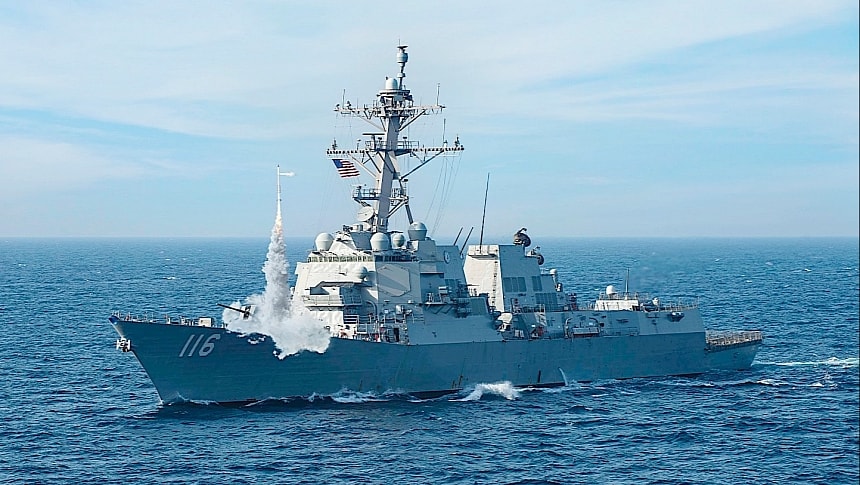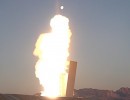In Greek mythology, the name aegis stands for a shield of sorts that Athena and Zeus used to carry with them. America's enemies, however, know the moniker as belonging to one of the most potent integrated combat systems in the world, deployed in the hands of the U.S. Navy.
Presently produced by defense contractor Lockheed Martin, the system is the backbone of naval defense not only for America's Navy, but also for partner nations. It is deployed on ships as a complete system comprising the missile launching element, the computer programs, the radar, the sensors, and the displays.
Aegis has been designed to work with a variety of weapons for the purpose of striking both airborne and surface threats. Hard work is presently ongoing to integrate newer and better missiles into the system, as well as new radars.
Recently, for instance, we learned of something called the Standard Missile-6 (SM-6) being put through its paces against a "threat-representative" mock target. Separately, a new type of radar capable of tracking objects in space is going through the motions of being integrated with the Aegis.
This week the system's maker, Lockheed Martin, announced another first for the Aegis system, its integration with something described as the world's most advanced air defense missile.
The thing's stage name is PAC-3 Missile Segment Enhancement (MSE), and in essence, it is a high-speed hit-to-kill device. What that means is it doesn't rely on blast fragmentation to get the job done, but goes for a body-to-body approach, meaning it directly impacts its target.
The missile has been designed to work against a variety of threats, including ones that can maneuver. That technically makes it effective against everything in the sky, including ballistic or supersonic missiles, and even aircraft.
The test we recently learned about took place at an undisclosed time and in an undisclosed location, and required the PAC-3 MSE to be launched from an MK-70 containerized platform. The mission, which appears to have been successful, was to engage a cruise missile in flight.
According to Lockheed Martin, this was the first time the missile in this configuration was launched using the virtual version of the Aegis, bringing the total of flight tests for the missile to over 90.
The defense contractor says it has already produced over 1,700 of these missiles, but it's unclear how many of them are already deployed in the service of the world's militaries.
For reference, there are presently some 110 warships packing the Aegis system, and an extra 70 are in line to get it in the coming years. Not only the American naval forces use this defense system, but also the Navies that sail under the flags of Australia, Japan, South Korea, Norway, and Spain.
Aegis has been designed to work with a variety of weapons for the purpose of striking both airborne and surface threats. Hard work is presently ongoing to integrate newer and better missiles into the system, as well as new radars.
Recently, for instance, we learned of something called the Standard Missile-6 (SM-6) being put through its paces against a "threat-representative" mock target. Separately, a new type of radar capable of tracking objects in space is going through the motions of being integrated with the Aegis.
This week the system's maker, Lockheed Martin, announced another first for the Aegis system, its integration with something described as the world's most advanced air defense missile.
The thing's stage name is PAC-3 Missile Segment Enhancement (MSE), and in essence, it is a high-speed hit-to-kill device. What that means is it doesn't rely on blast fragmentation to get the job done, but goes for a body-to-body approach, meaning it directly impacts its target.
The missile has been designed to work against a variety of threats, including ones that can maneuver. That technically makes it effective against everything in the sky, including ballistic or supersonic missiles, and even aircraft.
The test we recently learned about took place at an undisclosed time and in an undisclosed location, and required the PAC-3 MSE to be launched from an MK-70 containerized platform. The mission, which appears to have been successful, was to engage a cruise missile in flight.
According to Lockheed Martin, this was the first time the missile in this configuration was launched using the virtual version of the Aegis, bringing the total of flight tests for the missile to over 90.
The defense contractor says it has already produced over 1,700 of these missiles, but it's unclear how many of them are already deployed in the service of the world's militaries.
For reference, there are presently some 110 warships packing the Aegis system, and an extra 70 are in line to get it in the coming years. Not only the American naval forces use this defense system, but also the Navies that sail under the flags of Australia, Japan, South Korea, Norway, and Spain.









